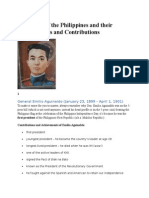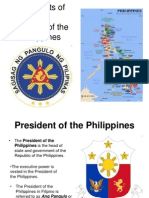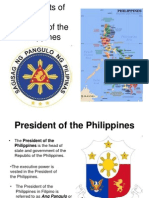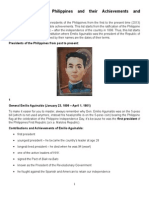0 ratings0% found this document useful (0 votes)
47 viewsPresidents of The Philippines Their Achievements And: Contributions
Presidents of The Philippines Their Achievements And: Contributions
Uploaded by
Jessmica Soldevillia RibeiroElpidio Quirino was the 6th president of the Philippines who served from 1948 to 1953. During his presidency, the Hukbalahap guerilla movement was active and he created agencies like the Social Security Commission and Integrity Board. Ramon Magsaysay succeeded him from 1953 to 1957 and quelled the Huk rebellion. He is remembered as the "Idol of the Masses" and his presidency marked a period of economic growth and less corruption. Carlos P. Garcia then served from 1957 to 1961 and pursued a policy favoring Filipino businesses over foreign investors. He also revived Philippine culture and arts.
Copyright:
© All Rights Reserved
Available Formats
Download as PPTX, PDF, TXT or read online from Scribd
Presidents of The Philippines Their Achievements And: Contributions
Presidents of The Philippines Their Achievements And: Contributions
Uploaded by
Jessmica Soldevillia Ribeiro0 ratings0% found this document useful (0 votes)
47 views22 pagesElpidio Quirino was the 6th president of the Philippines who served from 1948 to 1953. During his presidency, the Hukbalahap guerilla movement was active and he created agencies like the Social Security Commission and Integrity Board. Ramon Magsaysay succeeded him from 1953 to 1957 and quelled the Huk rebellion. He is remembered as the "Idol of the Masses" and his presidency marked a period of economic growth and less corruption. Carlos P. Garcia then served from 1957 to 1961 and pursued a policy favoring Filipino businesses over foreign investors. He also revived Philippine culture and arts.
Original Description:
Report in Polgov
Original Title
Presidents
Copyright
© © All Rights Reserved
Available Formats
PPTX, PDF, TXT or read online from Scribd
Share this document
Did you find this document useful?
Is this content inappropriate?
Elpidio Quirino was the 6th president of the Philippines who served from 1948 to 1953. During his presidency, the Hukbalahap guerilla movement was active and he created agencies like the Social Security Commission and Integrity Board. Ramon Magsaysay succeeded him from 1953 to 1957 and quelled the Huk rebellion. He is remembered as the "Idol of the Masses" and his presidency marked a period of economic growth and less corruption. Carlos P. Garcia then served from 1957 to 1961 and pursued a policy favoring Filipino businesses over foreign investors. He also revived Philippine culture and arts.
Copyright:
© All Rights Reserved
Available Formats
Download as PPTX, PDF, TXT or read online from Scribd
Download as pptx, pdf, or txt
0 ratings0% found this document useful (0 votes)
47 views22 pagesPresidents of The Philippines Their Achievements And: Contributions
Presidents of The Philippines Their Achievements And: Contributions
Uploaded by
Jessmica Soldevillia RibeiroElpidio Quirino was the 6th president of the Philippines who served from 1948 to 1953. During his presidency, the Hukbalahap guerilla movement was active and he created agencies like the Social Security Commission and Integrity Board. Ramon Magsaysay succeeded him from 1953 to 1957 and quelled the Huk rebellion. He is remembered as the "Idol of the Masses" and his presidency marked a period of economic growth and less corruption. Carlos P. Garcia then served from 1957 to 1961 and pursued a policy favoring Filipino businesses over foreign investors. He also revived Philippine culture and arts.
Copyright:
© All Rights Reserved
Available Formats
Download as PPTX, PDF, TXT or read online from Scribd
Download as pptx, pdf, or txt
You are on page 1of 22
Presidents of the Philippines
their Achievements and
Contributions
Elpidio Quirino
• 6th president of the Philippines
• In office: April 18, 1948 - December 30, 1953
• Vice President: Fernando Lopez (1949-19530)
• Political Party: Liberal Party
• Quirino retired to private life and died on heart attack
• in February 29, 1956
• Hukbalahap Guerilla movement active during his
presidency
• Created Social Security Commission
• Created Integrity Board to monitor graft and corruption
• Quezon City became capital of the Philippines in 1948
• He created rural banks
Hukbalahap Guirella Movement
Ramon Magsaysay
Born: 31 August 1907, Iba, Zambales
Died: 17 March 1957, Balamban
Full name: Ramón del Fierro Magsaysay
Cause of death: Plane Crash March 17, 1957
Presidential term: 30 December 1953 – 17 March 1957
• “Idol of the masses” peoples president
• Hukbalahap movement quelled during his
presidency
• Chairman of the committee on Guerrilla Affairs
• First president sworn into office wearing Barong
Tagalog during inauguration
• Presidency referred to as the Philippines Golden Years” for
its lack of corruption
• Philippines was ranked second in Asia’s Clean and well-
governed country during his presidency
• Established national resettlement and rehabilitation
Administration (NARRA) Among other agrarian reforms
Carlos P. Garcia
• Born: 4 November 1896, Captaincy General of the
Philippines
• Died: 14 June 1971, Quezon City
• Full name: Carlos Polistico García
• Presidential term: 18 March 1957 – 30 December 1961
• Known for “Filipino First Policy” which favored Filipino business over
foreign investors
• Established the austerity Program Focusing on Filipino trade and
commerce
• He implemented cultural revival and economic nationalism
• Supported local industries and encouraged local production
• Known as the “Prince of Visayan Poets” and the “Brad
from Bohol”
• Cultural and Arts was revived during his term
• The first president to have his remains buried at the
libingan ng mga bayani
• Known as the “Prince of Visayan Poets” and the “Brad from
Bohol”
• Cultural and Arts was revived during his term
• The first president to have his remains buried at the libingan
ng mga Bayani
Diosdado Macapagal
Born: 28 September 1910, Lubao
Died: 21 April 1997, Makati Medical Center, Makati
Full name: Diosdado Pangan Macapagal
Presidential term: 30 December 1961 – 30 December
1965
• Succeeded Garcia
• He is known for his socio-economic programs
• Abolition of tenancy
• Establishment of Land bank
• He changed the celebration of Independence Day from July 4 to June 2
• Established MAPHILINDO- Malaysia, Philippines and Indonesia
Ferdinand Marcos
• Born: 11 September 1917, Sarrat
• Died: 28 September 1989, Honolulu, Hawaii, United States
• Full name: Ferdinand Emmanuel Edralin Marcos
• Presidential term: 30 December 1965 – 25 February 1986
• Buried: 18 November 2016, Heroes' Cemetery, Taguig
• First President to win a second term
• Declared Martial Law on September 22, 1972
• Increased the number of Philippine Military and Armed
forces
• Instituted the Bagong Lipunan o “New Society”
• 1973 Constitution was adopted, and the Philippines have
modified parliamentary form of government.
• By 1980 the Philippines GNP was four times greater than
1972
• In 1980, the constitution was gain amended. With these
changes in the government structures. Marcos was able to
stay in the presidency longer and exercise greater powers
• By 1986 the Philippines was one of the most indebted
countries in Asia.
• During martial law, the political rights and civil liberties of the people as
well as the human rights were suppressed and violated
• The only president whose remains are interred inside a refrigerated crypt.
• Build more school, roads, bridges, hospitals and other infrastructure than all
former presidents combined.
You might also like
- Presidents of The PhilippinesDocument6 pagesPresidents of The Philippinesjean alexie90% (21)
- Presidents of The Philippines and Their Achievements and ContributionsDocument17 pagesPresidents of The Philippines and Their Achievements and ContributionsJadeal2880% (5)
- Let ReviewerDocument16 pagesLet ReviewerUlan100% (1)
- The Philippine National HeroesDocument22 pagesThe Philippine National HeroesRica100% (5)
- Presidents of The Philippines From Past To PresentDocument7 pagesPresidents of The Philippines From Past To PresentDock Ace100% (1)
- Great LeadersDocument12 pagesGreat LeadersWensore CambiaNo ratings yet
- Ghist Context AnalysisDocument2 pagesGhist Context AnalysisMITAmint0% (1)
- PRESIDENTS of The PHDocument6 pagesPRESIDENTS of The PHjason balmasNo ratings yet
- The 17 President of The Philippines With Their Accomplishments FinalizedDocument17 pagesThe 17 President of The Philippines With Their Accomplishments Finalizedtokkilian0908100% (1)
- UntitledDocument22 pagesUntitledsheena diazNo ratings yet
- Social Science CoverageDocument104 pagesSocial Science CoverageAllan Joneil LataganNo ratings yet
- The Philippines 17Document34 pagesThe Philippines 17Fiona Althea PancipanciNo ratings yet
- LEt Reviewer - L-WPS OfficeDocument6 pagesLEt Reviewer - L-WPS OfficeAngelica AbrigoNo ratings yet
- Presidents of The PhilippinesDocument17 pagesPresidents of The PhilippinesGabrielle KamNo ratings yet
- List of Philippine Presidents and Their ContributionsDocument4 pagesList of Philippine Presidents and Their ContributionsMelchie Repospolo100% (1)
- Philippine History Chapter 23: The Third Philippine RebuplicDocument20 pagesPhilippine History Chapter 23: The Third Philippine RebuplicAnnie Vinoray Balmaceda43% (7)
- PresidentsDocument39 pagesPresidentsringelivan2407No ratings yet
- Philippine PresidentsDocument9 pagesPhilippine PresidentsHannaNo ratings yet
- 17 PresidentsDocument18 pages17 PresidentsChritina kelly BagidNo ratings yet
- Presidents of The Philippines 2Document88 pagesPresidents of The Philippines 2roi constantineNo ratings yet
- List of Presidents and Their Major ContributionsDocument8 pagesList of Presidents and Their Major Contributionsapple mabinis100% (1)
- Presidents of The PhilippinesssDocument9 pagesPresidents of The Philippinessscyrilcastillo018No ratings yet
- Presidents of The PhilippinesDocument3 pagesPresidents of The PhilippinesNercylieMosquezaNo ratings yet
- Documents RCC BeDocument9 pagesDocuments RCC Becyrilcastillo018No ratings yet
- 1presidents of The Philippines and Their Achievements andDocument50 pages1presidents of The Philippines and Their Achievements andNivlem B ArerbagNo ratings yet
- History Report g3Document27 pagesHistory Report g3pulpulaan.jeremyNo ratings yet
- Presidents of The Philippines and Their Achievements andDocument43 pagesPresidents of The Philippines and Their Achievements andNivlem B ArerbagNo ratings yet
- Presidents of The PhilippinesDocument42 pagesPresidents of The PhilippinesAj de Castro88% (8)
- Presidents of The PhilippinesDocument38 pagesPresidents of The PhilippinesMay Ann GuintoNo ratings yet
- The History of President of Republic of The PhilippinesDocument50 pagesThe History of President of Republic of The PhilippinesAiza Mae MiradorNo ratings yet
- Presidents of The Philippines and Their Achievements andDocument43 pagesPresidents of The Philippines and Their Achievements andNivlem B Arerbag100% (1)
- 15 Presidents of The PhilDocument19 pages15 Presidents of The PhilJhuneMarie BucadNo ratings yet
- Philippine Presidents - Their Achievements and Contributions - INFINITHINKDocument12 pagesPhilippine Presidents - Their Achievements and Contributions - INFINITHINKGloriel Veiktor M SanchezNo ratings yet
- 12 Roxas Quirino and Magsaysay AdministrationDocument30 pages12 Roxas Quirino and Magsaysay AdministrationRiane VergaraNo ratings yet
- Philippine Politics and Governance Angelica Jenaiza MaravillaDocument21 pagesPhilippine Politics and Governance Angelica Jenaiza MaravillaDaisy Ann MoraNo ratings yet
- THE-THIRD-REPUBLIC-OF-THE-PHILIPPINESDocument13 pagesTHE-THIRD-REPUBLIC-OF-THE-PHILIPPINESton madrasoNo ratings yet
- PresidentsofthephilippinesDocument38 pagesPresidentsofthephilippinesDaniel Paulo MangampatNo ratings yet
- Document (2) 2Document11 pagesDocument (2) 2Razel ForrosueloNo ratings yet
- PresidentsDocument14 pagesPresidentsJauNo ratings yet
- 3rd RepublicDocument2 pages3rd RepublicJudeJunuisNo ratings yet
- 1987 CompositionDocument14 pages1987 CompositionIrish BusadreNo ratings yet
- Emilio Aguinaldo-1 Philippine President (January 23, 1899 - April 1, 1901)Document11 pagesEmilio Aguinaldo-1 Philippine President (January 23, 1899 - April 1, 1901)Jane Uranza CadagueNo ratings yet
- Art Works: Illustrations, Drawings, and PhotographsDocument9 pagesArt Works: Illustrations, Drawings, and PhotographsBpNo ratings yet
- Philippine PresidentsDocument2 pagesPhilippine PresidentsJohn Paul MangalusNo ratings yet
- Presidents of The Philippines and Their Achievements and ContributionsDocument12 pagesPresidents of The Philippines and Their Achievements and ContributionsYvette Pauline JovenNo ratings yet
- Presidents of The Philippines and Their Achievements and ContributionsDocument7 pagesPresidents of The Philippines and Their Achievements and ContributionsJenielyn MadarangNo ratings yet
- First PO in Comp 6 - CATOLINDocument18 pagesFirst PO in Comp 6 - CATOLINRhea PeñarandaNo ratings yet
- Phil PresidentsDocument16 pagesPhil PresidentsRetchel Cadayong NavalesNo ratings yet
- Presidents of The Philippines: Their Achievements and ContributionsDocument14 pagesPresidents of The Philippines: Their Achievements and ContributionsJin Amatorio0% (1)
- PPG Lesson 5 The Philippine PresidentDocument55 pagesPPG Lesson 5 The Philippine PresidentSan Roque Parochial School Inc.No ratings yet
- Cheverlie Mae HISTORYDocument32 pagesCheverlie Mae HISTORYjanamaribaldicanaNo ratings yet
- Presidents of The Philippines and Their Achievements and ContributionsDocument19 pagesPresidents of The Philippines and Their Achievements and ContributionsdellcyberNo ratings yet
- Presidents of The PhilippinesDocument12 pagesPresidents of The PhilippinesSharmine TejanoNo ratings yet
- Filipino Great Men and Women: Miriam Defensor SantiagoDocument6 pagesFilipino Great Men and Women: Miriam Defensor SantiagoGlyddelNo ratings yet
- List of President of The Philippines and Their Achievements and ContributionsDocument26 pagesList of President of The Philippines and Their Achievements and ContributionsSherene Racoma100% (1)
- Presidents of The Philippines From Past To PresentDocument23 pagesPresidents of The Philippines From Past To PresentRica100% (1)
- Emilio Aguinaldo 1899-1901: 2. Manuel L. Quezon, 1935-1944Document6 pagesEmilio Aguinaldo 1899-1901: 2. Manuel L. Quezon, 1935-1944LucasNo ratings yet
- Pocket Guide to the Philippine Struggle for IndependenceFrom EverandPocket Guide to the Philippine Struggle for IndependenceNo ratings yet
- Roberto GandioncoDocument4 pagesRoberto GandioncoBruce Lee Delos Santos100% (2)
- Gandara, Samar (Western Samar)Document2 pagesGandara, Samar (Western Samar)SunStar Philippine NewsNo ratings yet
- Filipino-2 Periodical-Test q1Document8 pagesFilipino-2 Periodical-Test q1Roselyn HerreraNo ratings yet
- LOCATOR SLIP (Permission To Leave Station)Document8 pagesLOCATOR SLIP (Permission To Leave Station)Kresta BenignoNo ratings yet
- 16th National Convention of LawyersDocument4 pages16th National Convention of Lawyersjay dz100% (1)
- Filipino Sa Piling LaranganDocument27 pagesFilipino Sa Piling Larangansebastianmateo985No ratings yet
- BADAKDocument5 pagesBADAKmennaldz0% (1)
- Contemporary Arts in The PhilippinesDocument86 pagesContemporary Arts in The PhilippinesjhomalynNo ratings yet
- MindanaoDocument8 pagesMindanaoRenzo jognoNo ratings yet
- Inbound 8999926894763750175Document6 pagesInbound 8999926894763750175adaniel.spticNo ratings yet
- PT Q1 MATH3.docx-BAGALAYOSDocument11 pagesPT Q1 MATH3.docx-BAGALAYOSANNALYN VINESNo ratings yet
- Sandugong PanaginipDocument3 pagesSandugong PanaginipArleneNo ratings yet
- National Artists For TheaterDocument4 pagesNational Artists For TheaterAijhaigh VeraNo ratings yet
- Sales Staff NCR MasterfileDocument30 pagesSales Staff NCR MasterfileJane Rose AsueroNo ratings yet
- Barangay Clearance NewDocument92 pagesBarangay Clearance NewJayvee JoseNo ratings yet
- Orv Grade 7 and 10 Cagay NHSDocument8 pagesOrv Grade 7 and 10 Cagay NHSEmmanuel Jess AguilarNo ratings yet
- The Literary Forms in Philippine LiteratureDocument6 pagesThe Literary Forms in Philippine Literaturenica-chan0% (2)
- Comelec Nanawagan Sa Payapang Halalan 2022: Comelec Gives In: Voter Registration To Be Extended Until October 31Document1 pageComelec Nanawagan Sa Payapang Halalan 2022: Comelec Gives In: Voter Registration To Be Extended Until October 31John Paul ObleaNo ratings yet
- Issue in Philippine HistoryDocument2 pagesIssue in Philippine HistoryThe PsychoNo ratings yet
- ALARVA ANDALUZ BINUYA - GED0104 - Section20 - SA1 S - SAMANTHA LAUREN BINUDocument10 pagesALARVA ANDALUZ BINUYA - GED0104 - Section20 - SA1 S - SAMANTHA LAUREN BINUSamantha Lauren BinuyaNo ratings yet
- General Mamerto Natividad, Nueva EcijaDocument2 pagesGeneral Mamerto Natividad, Nueva EcijaSunStar Philippine NewsNo ratings yet
- Wedding Dance by Amador DaguioDocument7 pagesWedding Dance by Amador DaguioRoyce Cunanan100% (6)
- Nestor Labidon: Make/Type Motor Number Chassis Number Plate No. Mitsubishi 733427 LTC-9K-226-73 JVC-237Document16 pagesNestor Labidon: Make/Type Motor Number Chassis Number Plate No. Mitsubishi 733427 LTC-9K-226-73 JVC-237Shan KhingNo ratings yet
- Psychometricians 10-2019 Room AssignmentDocument53 pagesPsychometricians 10-2019 Room AssignmentPRC BaguioNo ratings yet
- Qualified Contestable Customers - March 2021 DataDocument61 pagesQualified Contestable Customers - March 2021 DataCarissa May Maloloy-onNo ratings yet
- Reinstatement CasesDocument7 pagesReinstatement CasesMeeJeeNo ratings yet
- 2021 SGLG Utilization of 20 IRA For LDP - ProvinceDocument2 pages2021 SGLG Utilization of 20 IRA For LDP - ProvinceMaybelle Blossom Dumlao-SevillenaNo ratings yet
- Cesc PPT Week 6Document16 pagesCesc PPT Week 6John Rey TumaliuanNo ratings yet
- CBM 321 Final Research PaperDocument20 pagesCBM 321 Final Research PaperLealyn CuestaNo ratings yet

























































































